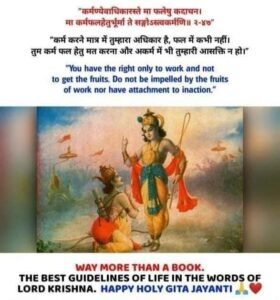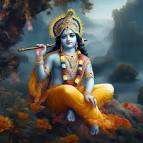Shrimad Bhagwat Gita Is A Manual For Life And Living
Dr. Naresh Purohit*, our regular contributor on Community Healthcare, delves into spiritual aspect of Life and Karma on 'Gita Jayanti Day'
New Delhi/Bhopal: The Bhagwat Gita is a manual for life and living. The Gita presents the laws and principles on which life works. Well before there was any concept of ‘Hinduism’, thousands of years ago, our ancestors called themselves the arya putra or ‘Noble Race.’
The result of this philosophy was prosperity, harmony and spiritual growth. The philosophy created a conducive environment for people to reflect on higher pursuits of life.
The Gita provides invaluable guidance to on how to deal with the fundamental issue of making correct choices and taking the right decisions.
Among scriptures of the world, the Shrimad Bhagvad Gita holds a unique place. Presented as a dialogue between Bhagwan Shri Krishna and Arjuna on the battlefield of Kurukshetra, it was composed for the benefit of humankind by Maharshi Ved Vyasa. In 700 metrical shlokas, it contains the essence of the teachings of the Upanishads. So naturally , self-knowledge — the subject matter of the Upanishads is its main theme. Not withstanding the fact that its content is based on the Upanishads, the Gita has a special prominence.
Simple and straightforward, the message of the Gita is to look at life as a whole and live a whole life. Don’t live it in fragments. Don’t live it partially. Don’t look at life only from one angle; take an aerial view. Flying in a helicopter one gets the larger perspective, the overall picture. As the craft descends, we can individually view each corner, look in every direction. This is exactly what Shri Krishna did for Arjuna. He suddenly lifted him to a great height and made him observe the situation from the highest standpoint. Then He came down to the ground realities and explained the different perspectives of life from various levels. He taught him how to examine the impending war from the absolute standpoint as well as from the many relative standpoints.
The Gita was given to the skilled and noble Arjuna when he became despondent on the battlefield at Kurukshetra, unable to withstand the challenge of having to fight his own relatives, teachers and friends. The message of the Gita given by Krishna revived him despite the incapacitated state he was in.
The Gita can be divided into three parts of six chapters each. These three parts are said to represent the great upanishadic aphorism, Tat Tvam Asi, You Are That.
The first part talks about ‘tvam’, you, the individual. You meet challenges and are overwhelmed by them. You need to understand the purpose of life and conduct yourself accordingly. Doing that is your duty; it is karma yoga, path of action. Karma yoga is working for a higher cause in the spirit of cooperative endeavour. When a person functions thus his worldly desires wane away and he is prepared for meditation. Through meditation he realises his Self, the purpose of existence. The most famous verse in this section is probably karmanyevadhikaraste (II.47) – your right is to action and no right to claim its fruit.
The second part talks of ‘tat’ that, the Supreme Reality, God. Krishna shows how Reality or God is in everything and everything is in God. He demonstrates this both by analyses and syntheses. He names individual things and says they are God and then puts it all together, synthesises them in the form of Vishwarupa, His cosmic form. In it, Arjuna sees how everything is part of Krishna or Reality, the good, the bad and the ugly. 
Whatever one sees is a manifestation of the Lord. With this vision one’s mind expands in love and demonstrates the first quality of a bhakta, a devotee of God – advesta sarva bhutanam, maitra, karuna eva cha. That is, no hatred towards any being, and to be friendly, compassionate (XII.13).
The third section talks about ‘Asi’, are, the relationship between the individual and God. He is the root and the world is the tree, the inverted ashvatha tree. Like any family tree, the parent is shown on top and the descendants below. The world is made up of the three gunas – tamas, ignorance; rajas, activity; and sattva, poise. They bind us in different ways and keep us from recognition of Reality. Beings in the world are all different – but different combinations of the three gunas. When one goes beyond the gunas one finds one’s true Self.
The text ends with Arjuna overcoming the state of depression he was falling into and he is now ready to do his duty and fight a righteous war, Sanjaya tells us that where there is the skill of Arjuna and the yoga of Krishna – these are values they symbolise – there will be success, prosperity, victory and sound policy.
____________________________________________
*Dr Naresh Purohit (Advisor- National Mental Health Programme And Principal Investigator for the Association of Studies Of Mental Care ). Dr. Purohit is also advisor to Ministry of Health & Family Welfare, Govt. of India on Communicable Diseases, and other health issues.
And Principal Investigator for the Association of Studies Of Mental Care ). Dr. Purohit is also advisor to Ministry of Health & Family Welfare, Govt. of India on Communicable Diseases, and other health issues.

Comments are closed.